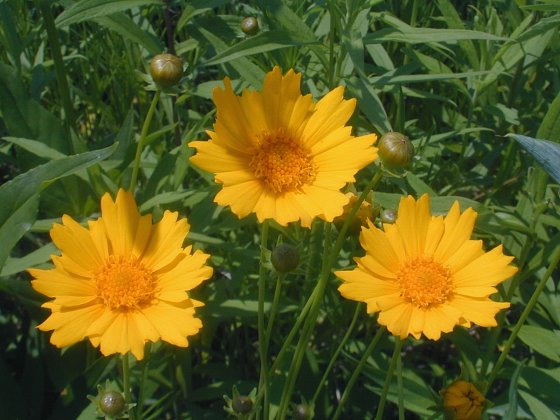
|
Family: Asteraceae |
Annuals, perennials, subshrubs, or shrubs, 10-80(-200+) cm (often rhizomatous or with cormiform bases, stoloniferous in C. auriculata). Stems usually 1, erect, branched distally or ± throughout. Leaves basal, basal and cauline, or cauline; opposite or alternate or both; petiolate or sessile; blades simple and entire (dentate in C. latifolia), or ± pinnately or pedately lobed, faces glabrous or hairy. Heads radiate, borne singly or in open, ± corymbiform arrays. Calyculi of (3-)8+, distinct, ± herbaceous bractlets. Involucres ± globose to cylindric, 4-25+ mm diam. Phyllaries usually ± 8 in ± 2 series (usually distinct, rarely connate ± 1/10 their lengths, mostly oblong to linear, ± membranous, margins ± scarious). Receptacles flat to convex, paleate; paleae falling, ovate to linear or subulate, ± flat, ± scarious (not adnate to and not falling with cypselae except in C. bigelovii). Ray florets mostly (5-)8(-12+, more in 'double' cultivars), neuter, or styliferous and sterile, or pistillate and fertile; corollas usually yellow, sometimes red-brown to purple proximally, sometimes wholly purple or pink to white. Disc florets 8-150+, bisexual, fertile; corollas usually yellow, sometimes red-brown to purple at tips or throughout, tubes equaling or shorter than narrowly funnelform throats, lobes 4 or 5 (adaxial sinus seldom deeper than others). Cypselae obcompressed, ± orbiculate to ovate, oblong, or linear, usually thin-margined or winged, wings membranous to chartaceous or corky, entire or lobed to toothed, sometimes ciliolate; faces smooth or ± papillate to tuberculate; pappi 0, or persistent, of 2 bristly cusps or scales (sometimes pappi 0 and shoulders of cypsela wings ± bristly, pappus-like). x = 14. In such plants, early (proximal) leaves may be 1-3-pinnately or pedately lobed and 12-25+ cm long with 9-15+ orbiculate to lanceolate, linear, or filiform lobes and contrast markedly with later (distal) leaves 1-3 cm that are undivided or have 3-5+ lanceolate to linear or filiform lobes. Cultivars (often 'doubles' with multiple series of 'ray' florets) derived from Coreopsis auriculata, C. grandiflora, C. lanceolata, and C. tinctoria are grown in public and residential gardens and are grown commercially for cut flowers.
Heads radiate, the rays few, often 8, conspicuous, usually neutral, yellow or rarely pink or white, sometimes marked with reddish-brown at base; invol bracts biseriate and dimorphic, all joined at the base, the outer narrower and usually shorter, commonly more herbaceous than the inner; receptacle flat or slightly convex, its bracts thin and flat; disk-fls perfect and fertile; style-branches flattened, with short or elongate, subtruncate to caudate, hairy appendage; achenes flattened parallel to the invol bracts, usually winged, not beaked; pappus of 2 smooth or upwardly barbed, short awns or teeth, or a minute crown, or obsolete; herbs (ours) with opposite or rarely alternate, entire to pinnatifid or ternate or dissected lvs. 100, mainly New World. Gleason, Henry A. & Cronquist, Arthur J. 1991. Manual of vascular plants of northeastern United States and adjacent Canada. lxxv + 910 pp. ©The New York Botanical Garden. All rights reserved. Used by permission. |
This project was made possible in part by the Institute of Museum and Library Services [MG-70-19-0057-19].
Powered by Symbiota



